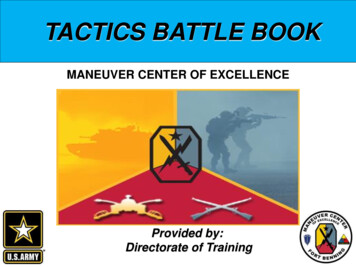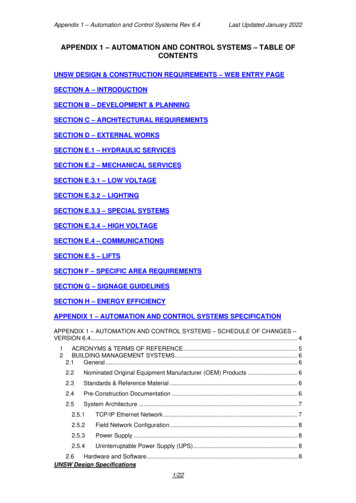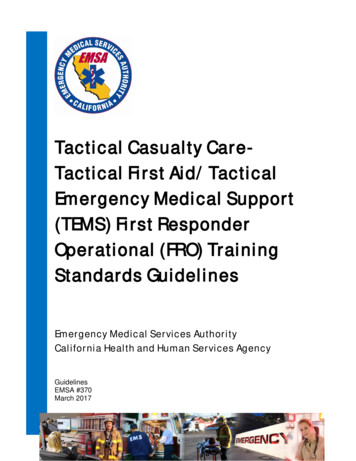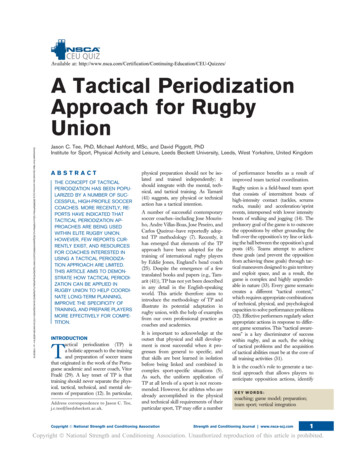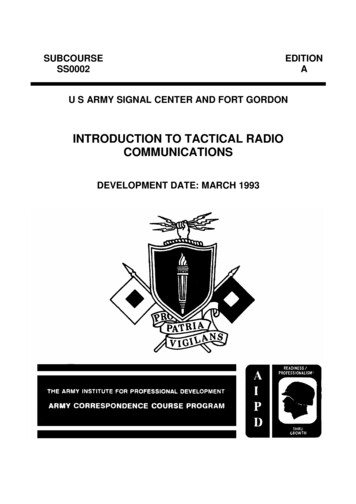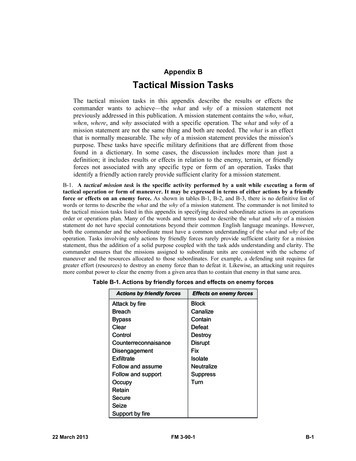
Transcription
Appendix BTactical Mission TasksThe tactical mission tasks in this appendix describe the results or effects thecommander wants to achieve—the what and why of a mission statement notpreviously addressed in this publication. A mission statement contains the who, what,when, where, and why associated with a specific operation. The what and why of amission statement are not the same thing and both are needed. The what is an effectthat is normally measurable. The why of a mission statement provides the mission’spurpose. These tasks have specific military definitions that are different from thosefound in a dictionary. In some cases, the discussion includes more than just adefinition; it includes results or effects in relation to the enemy, terrain, or friendlyforces not associated with any specific type or form of an operation. Tasks thatidentify a friendly action rarely provide sufficient clarity for a mission statement.B-1. A tactical mission task is the specific activity performed by a unit while executing a form oftactical operation or form of maneuver. It may be expressed in terms of either actions by a friendlyforce or effects on an enemy force. As shown in tables B-1, B-2, and B-3, there is no definitive list ofwords or terms to describe the what and the why of a mission statement. The commander is not limited tothe tactical mission tasks listed in this appendix in specifying desired subordinate actions in an operationsorder or operations plan. Many of the words and terms used to describe the what and why of a missionstatement do not have special connotations beyond their common English language meanings. However,both the commander and the subordinate must have a common understanding of the what and why of theoperation. Tasks involving only actions by friendly forces rarely provide sufficient clarity for a missionstatement, thus the addition of a solid purpose coupled with the task adds understanding and clarity. Thecommander ensures that the missions assigned to subordinate units are consistent with the scheme ofmaneuver and the resources allocated to those subordinates. For example, a defending unit requires fargreater effort (resources) to destroy an enemy force than to defeat it. Likewise, an attacking unit requiresmore combat power to clear the enemy from a given area than to contain that enemy in that same area.Table B-1. Actions by friendly forces and effects on enemy forcesActions by friendly forcesAttack by sengagementExfiltrateFollow and assumeFollow and supportOccupyRetainSecureSeizeSupport by fire22 March 2013Effects on enemy solateNeutralizeSuppressTurnFM 3-90-1B-1
Appendix BTable B-2. Elements of operations and subordinate tasksElements of operationsOffensive tasksDefensive tasksMovement to contact:Area defense Search and attackCordon and searchAttack: Mobile defenseAmbushDemonstrationFeintRaidSpoiling attackExploitationRetrograde operations DelayWithdrawalRetirementPursuitForms of offensive maneuver EnvelopmentFrontal attackInfiltrationPenetrationTurning movementTable B-3. Tactical shaping operations and tasksTactical shaping tasksPassage of linesReconnaissance operations ZoneAreaRouteReconnaissance in forceRelief in placeSecurity operations: ScreenGuardCoverArea (includes route and convoy)LocalTroop movements: Administrative movementApproach marchRoad marchB-2. Many of the tactical mission tasks in this appendix or introduced previously in this publication have atactical mission graphic associated with them. Commanders and staff officers use tactical mission graphicsin conjunction with course of action development.B-2FM 3-90-122 March 2013
Tactical Mission TasksACTIONS BY FRIENDLY FORCESB-3. The following tactical mission tasks address actions by friendly forces. They are the action, the what,the commander wants the friendly force to perform. Most of these actions have associated tactical missiongraphics that are used in course of action development and sketches as part of the military decisionmakingprocess.ATTACK BY FIREB-4. Attack by fire is a tactical mission task in which a commander uses directfires, supported by indirect fires, to engage an enemy force without closing withthe enemy to destroy, suppress, fix, or deceive that enemy. A commander assigningthis task to a subordinate must also state the desired effect on the enemy, such asneutralize, fix, or disrupt. A commander normally employs this task when the missiondoes not dictate or support close combat and occupation of a geographical objective byFigure B-1.another friendly force. The commander may assign the force conducting an attack by Attack by firefire a battle position with either a sector of fire or an engagement area (EA), or thetacticalcommander may assign it an axis of advance and a force-oriented objective. The enemymissionmay be stationary or moving. Figure B-1 shows the tactical mission graphic for attackgraphicby fire. The arrow points at the targeted force or objective, and the commander placesthe base of the arrow in the general area from which the commander wants to deliver the attack.B-5. An attack by fire closely resembles the task of support by fire. The chief difference is that one unitconducts the support by fire task to support another unit so it can maneuver against the enemy. The attackby fire task includes— Assigning sectors of fire or EAs to each subordinate weapon system to include the enemy’sdefensive positions or avenues of approach. Designating control measures to allow massing, distributing, and shifting of direct and indirectfires. Designating battle positions, area of operations (AO), or axis of advance to allow the friendlyforce to engage the enemy. Providing for security and all-around defense, including control measures to ensure tie-in ofsubordinate elements and maximum use of hide positions. Using operations security (OPSEC) to deceive the enemy about movement, occupation, andintent of the operation. Reconnoitering, preparing, and securing movement routes and firing positions before themovement of the main body, and stocking Class V items. Providing movement instructions to the initial battle positions.BREACHB-6. Breach is a tactical mission task in which the unit employs all available means tobreak through or establish a passage through an enemy defense, obstacle, minefield, orfortification. A commander attempts to bypass and avoid obstacles and enemy defensivepositions to the maximum extent possible to maintain tempo and momentum. Breachingenemy defenses and obstacle systems is normally the last choice. A breach is a synchronizedFigure B-2.combined arms operation under the control of the maneuver commander. (Figure B-2 showsBreachtacticalthe control graphic for a breach.) The area located between the arms of the graphic shows themissiongeneral location for the breach. The length of the arms extend to include the entire depth of thegraphicarea that must be breached. Breaching operations may be required to support an attackanywhere along the continuum from a deliberate to a hasty attack. Regardless of where the attack falls alongthe continuum, the breaching tenets—intelligence, breaching fundamentals, breaching organization, mass,and synchronization—apply when conducting breaching operations in support of an attack. (ATTP 3-90.4gives detailed information concerning breaching operations.)22 March 2013FM 3-90-1B-3
Appendix BBYPASSB-7. Bypass is a tactical mission task in which the commander directs the unit to maneuver aroundan obstacle, position, or enemy force to maintain the momentum of the operation while deliberatelyavoiding combat with an enemy force. A commander orders a bypass and directs combat power towardmission accomplishment. A bypass can take place in offensive or defensive actions. (Figure B-3 shows thetactical mission graphic for a bypass.) The arms of the graphic go on both sides of the location or unit thatwill be bypassed.B-8. The commander bases the bypass decision on— The requirement to maintain momentum and aggressive action. Knowledge of enemy strength, intent, or mission. The degree to which the bypassed enemy can interfere with the advance. The general state of the enemy force; for example, if enemy resistance iscrumbling, the friendly force can take greater risks. Any bypass criteria established by a higher headquarters.Figure B-3.BypasstacticalmissiongraphicB-9. The force conducting the bypass immediately reports any bypassed obstacles andenemy forces to its higher headquarters. The force normally keeps the bypassed enemyunder observation until relieved by another force, unless it is part of a raid. A senior commander does notnormally delegate authority to bypass below the battalion task force level. Bypass criteria are established tolimit the size of the enemy force that can be bypassed without the authority of the next higher commander.Before approving the bypass, the commander ensures that the bypassing force checks the bypass route forenemy presence and trafficability. The bypassing force prevents the bypassed enemy force from interferingwith the moving friendly force.B-10. The two bypass techniques that the force can employ are— Avoiding the enemy totally. Fixing the enemy in place with fires and then conducting the bypass.B-11. If the force cannot avoid the enemy,the bypassing force must fix the enemywith part of its maneuver elements andbypass with the balance of the force. (Seefigure B-4.) Generally, a commander willnot attempt to bypass an enemy force ifmore than a third of the unit’s combatpower is required to fix the enemy. Thecommander assigns one subordinate unitthe mission of fixing the enemy in thissituation, reinforcing the fixing force asrequired by the mission variables ofmission, enemy, terrain and weather,troops and support available, timeavailable, and civil considerations(METT-TC.) The fixing force coordinateswith the unit assigned to relieve the fixing Figure B-4. Task force conducting a fix and bypassforce as soon as possible and provides thenew commander with all available information about the enemy and terrain. The relieving unit is normallyanother unit assigned a follow-and-support task. Once relieved, the force fixing the enemy either rejoins itsparent organization or becomes part of the following element and comes under its control.B-12. Occasionally the commander may direct the fixing force to break contact with the enemy after thebypassing force completes the bypass. This occurs when the bypassing force has no requirement tomaintain an uninterrupted logistics flow, such as in a raid. In this case, the fixing force fixes the enemy byemploying defensive and limited offensive actions in synchronization with all available fire support untilordered to rejoin the bypassing force.B-4FM 3-90-122 March 2013
Tactical Mission TasksClearB-13. Clear is a tactical mission task that requires the commander to remove all enemy forces andeliminate organized resistance within an assigned area. The force does this by destroying, capturing, orforcing the withdrawal of enemy forces, so they cannot interfere with the friendly unit’s mission. In allcases, this task requires a thorough reconnaissance to discover the enemy’s locations. After discovering theenemy’s location, the clearing force maneuvers against the enemy force. (Figure B-5 shows the tacticalmission graphic for clear.) The bar connecting the arrows designates the desired limit of advance for theclearing force. The bar also establishes the width of the area to clear.B-14. This task requires significant time and other resources. In the missionstatement, a commander can modify the objective associated with this task todestroying, capturing, or forcing the withdrawal of only enemy forces larger than astated size. In this case, the clearing force keeps smaller enemy forces underobservation, while the rest of the friendly force bypasses them.B-15. Clear is also a mobility task that involves the total elimination of an obstaclethat is usually performed by follow-on engineers and is not done under fire.Clearing operations are conducted to completely eliminate the enemy’s obstacleeffort or residual obstacles affecting the operational area. (See FM 3-34.210 formore information on mobility clearing operations.)Figure B-5. Cleartactical missiongraphicCONTROLB-16. Control is a tactical mission task that requires the commander to maintain physical influenceover a specified area to prevent its use by an enemy or to create conditions necessary for successfulfriendly operations. That influence can result from friendly forces occupying the specified area ordominating that area by their weapon systems. Control of an area does not require the complete clearanceof all enemy soldiers from the specified area. The tactical mission task of control differs from that of securebecause secure does not allow enemy fires to impact on the secured area. The enemy can engage targetswithin the controlled area but cannot move ground forces through that area.B-17. Control may also mean a command relationship or a function commanders exercise through theirmission command systems. (See ADRPs 3-0 and 6-0.)COUNTERRECONNAISSANCEB-18. Counterreconnaissance is a tactical mission task that encompasses all measures taken by acommander to counter enemy reconnaissance and surveillance efforts. Counterreconnaissance is nota distinct mission, but a component of all forms of security operations. It prevents hostile observationof a force or area. Counterreconnaissance is an element of all security operations and most local securitymeasures. It involves both active and passive elements and includes combat action to destroy or repelenemy reconnaissance units and surveillance assets.B-19. Destroying enemy ground reconnaissance assets while denying the enemy information through othercollection systems allows friendly force commanders to operate against an enemy who is operating blindly.The enemy commander’s inability to see the battlefield eventually desynchronizes the enemy commander’sactions and renders that commander’s force vulnerable to aggressive action by friendly forces. (See chapter12 for additional information on counterreconnaissance.)DISENGAGEB-20. Disengage is a tactical mission task where a commander has the unit break contact with theenemy to allow the conduct of another mission or to avoid decisive engagement. It involves moving toa location where the enemy cannot engage the friendly force with either direct fires or observed indirectfires. Disengaging from the enemy while displacing from one position to the next is a difficult procedure. Adisengagement plan includes—22 March 2013FM 3-90-1B-5
Appendix B The maneuver concept of operations for tactical elements after disengagement, along with themovement routes for each subordinate unit.Fires to suppress the enemy and cover the unit’s movement.Screening smoke to conceal the unit’s movement, as part of a military deception operation, or tocover passage points.Contact and passage points if moving through friendly lines. (See FM 3-90-2.)The time disengagement starts.The earliest time that functional and multifunctional support and sustainment elements move.B-21. The senior headquarters conducts operations to support the disengaging forces and relieve pressureon units in contact with the enemy. For example, if a division is conducting a delay, the divisioncommander uses attached aviation assets to help a brigade combat team (BCT) disengage from the closefight. Simultaneously, the division uses its long-range artillery, rocket, and electronic warfare (EW)systems to destroy or disrupt enemy follow-on echelons to prevent them from interfering with thedisengagement. The intent is to create conditions that allow the unit to disengage while avoiding decisivecombat.B-22. To facilitate disengagement, the commander suppresses the enemy in contact by bombarding the enemyforce with large volumes of both direct and indirect fires provided by forces other than the disengaging unit. In openterrain, the unit generally moves its short-range systems first. In close terrain, it generally moves its long-rangesystems first to support by fire positions. The time involved to move a system to its next position also affects whenthat system moves. Small-unit leaders usually direct this movement because of the limited range of combat netradios and the fact that the tactical situation varies across a unit’s front. The process repeats as necessary. Oncedisengagement starts, units must complete it rapidly. The commander can employ supporting units or reserves toprotect the disengaging unit’s flanks and assist in freeing any closely engaged elements. The unit then moves to itsnext position using the appropriate movement techniques. (See FM 3-90-2.)B-23. If enemy combat systems have not closed within direct-fire range of the friendly disengaging unit, allits elements may be able to move simultaneously under the cover of intense fires and smoke. Speed ofexecution and continued coordination are essential to the success of this task.EXFILTRATEB-24. Exfiltrate is a tactical mission task where a commander removes Soldiers or units from areasunder enemy control by stealth, deception, surprise, or clandestine means. Friendly forces exfiltratewhen they have been encircled by enemy forces and cannot conduct a breakout or be relieved by otherfriendly forces. Forces returning from a raid, an infiltration, or a patrol behind enemy lines can also conductan exfiltration. The commander exfiltrates an encircled force to preserve a portion of the force; it ispreferable to the capture of the entire force. A force exfiltrates only after destroying or incapacitating allequipment, except medical, that it must leave behind. Only as a last resort, when the alternative is thecapture of the entire force, does a force conducting an exfiltration leave its casualties in place with supplies,chaplain support, and medical personnel.B-25. Exfiltration is most feasible through rough or difficult terrain in areas lightly covered by enemyobservation and fire. These conditions often allow undetected movement of small elements, whenmovement of the entire force would present more risk. Exfiltration requires resourcefulness, a high degreeof discipline, expert land navigation skills, and motivation. It is unlikely that the entire force will be able toexfiltrate, since part of it may have to create a diversion. Good, small-unit leadership is essential in thistype of operation.B-26. The exfiltrating force first establishes its rally points and exfiltration lanes. It coordinates its linkupplans with other friendly units. The commander designates exfiltration lanes as restrictive fire areas (RFAs)or no-fire areas (NFAs). The exfiltrating force uses preparatory fires to cover its movement and to expendstockpiled ammunition. Based on reconnaissance and available intelligence, the exfiltrating forcesubdivides into small groups and exfiltrates during periods of limited visibility, passing through or aroundenemy defensive positions. If detected, it tries to bypass the enemy. Exfiltration may be more difficult withB-6FM 3-90-122 March 2013
Tactical Mission Taskscombat and tactical vehicles because the noise they make and the limitations they impose on exfiltrationroutes make detection more likely.FOLLOW AND ASSUMEB-27. Follow and assume is a tactical mission task in which a second committed force follows a forceconducting an offensive task and is prepared to continue the mission if the lead force is fixed,attrited, or unable to continue. The follow-and-assume force is not a reserve but is committed toaccomplish specific tasks. Figure B-6 shows the tactical mission graphic for follow and assume. Thecommander places the box part of the graphic around the symbol of the unit being assigned this task.B-28. Tasks for a follow-and-assume force include— Preparing to execute all missions of the followed unit. Maintaining contact with the trail elements of the leading force. Preparing to conduct a forward passage of lines through the force it is following. Monitoring all combat information and intelligence being provided to and from the force it isfollowing. Avoiding engaging enemy forces bypassed by the force it is following.Figure B-6. Follow and assume tactical mission graphicB-29. A commander assigns a follow-and-assume mission to ensure that the attacking force maintains themomentum of its offensive action. The follow-and-assume force ensures that it can immediately execute aforward passage of lines and assume the mission of the lead force.B-30. The commander assigning a unit the task of follow and assume has two options in establishing therelationship between the lead and trail units. The commander normally retains command of both units andrequires that all requests for support from the supported unit to the supporting unit pass through thecommander’s headquarters. Alternatively, in situations where the commander will not be able to maintaincontrol over both units, the supporting unit is placed in a standard command relationship with the supportedunit, such as attached or operational control. An example of this occurs when both units are trying toencircle a retrograding enemy force and the commander remains with the direct-pressure force.22 March 2013FM 3-90-1B-7
Appendix BFOLLOW AND SUPPORTB-31. Follow and support is a tactical mission task in which a committed force follows and supports alead force conducting an offensive task. The follow-and-support force is not a reserve but is a forcecommitted to specific tasks. (Figure B-7 shows the tactical mission graphic for follow and support.) Thecommander places the box part of the graphic around the symbol of the unit being assigned this task.B-32. Tasks for a follow-and-support force include— Destroying bypassed enemy units when the lead unit does not clear the AO as it advances. Blocking movement of enemy reinforcements. Relieving in place any direct-pressure or encircling force halted to contain the enemy. Securing lines of communication. Clearing obstacles. Guarding prisoners, key areas, and installations. Recovering friendly battle losses. Securing key terrain. Controlling dislocated civilians.Figure B-7. Follow and support tactical mission graphicB-33. A commander assigns a unit the task of follow and support to keep the supported force from havingto commit its combat power to tasks other than the decisive operation, which would slow the offensiveoperation’s momentum and tempo. The follow-and-support force accomplishes its tasks to prevent theenemy, obstacles, and other factors from interfering with offensive actions, especially along the lines ofcommunications.B-34. The commander assigning the follow-and-support task has two options in establishing therelationship between the supported and the supporting units. The commander can place thefollow-and-support unit in a standard command relationship with the supported unit, such as attached oroperational control. Alternatively, the commander can retain command of the follow-and-support force andrequire that all tasking requests from the supported unit go through the commander’s headquarters.B-8FM 3-90-122 March 2013
Tactical Mission TasksOCCUPYB-35. Occupy is a tactical mission task that involves moving a friendly force intoan area so that it can control that area. Both the force’s movement to andoccupation of the area occur without enemy opposition. A unit can control an areawithout occupying it, but not vice versa. That is the difference between the tacticalmission tasks of occupy and control. (Figure B-8 shows the occupy tactical missiongraphic. The X on the tactical mission graphic has no significance, but the graphicshould encompass the entire area that the commander desires to occupy.) Unitstypically occupy assembly areas, objectives, and defensive positions.REDUCEFigure B-8.OccupytacticalmissiongraphicB-36. Reduce is a tactical mission task that involves the destruction of an encircledor bypassed enemy force. There is no tactical mission graphic for this task. This task can occur at anylocation on the battlefield. (FM 3-90-2 discusses the reduction of an encircled enemy.) Reduce is also amobility task that involves creating and marking sufficient lanes through, over, or around an obstacle tonegate its intended effect (ATTP 3-90.4).RETAINB-37. Retain is a tactical mission task in which the commander ensures that aterrain feature controlled by a friendly force remains free of enemy occupation oruse. The commander assigning this task specifies the area to retain and the duration ofthe retention, which is time- or event-driven. While a unit is conducting this task, itexpects the enemy to attack and prepares to become decisively engaged. A unit taskedto retain a specific piece of terrain does not necessary have to occupy it. (Figure B-9shows the tactical mission graphic for retain. The direction of the arrow has nosignificance, but the graphic includes the entire area the commander wants to retain.)SECUREFigure B-9.Retain tacticalmissiongraphicB-38. Secure is a tactical mission task that involves preventing a unit, facility, orgeographical location from being damaged or destroyed as a result of enemyaction. This task normally involves conducting area security operations. (See FM 3-90Volume 2.) A force given the mission of securing a unit, facility, or geographicallocation, such as a route or base, not only prevents enemy forces from over-running oroccupying the secured location, but also prevents enemy direct fires and observedFigure B-10.indirect fires from impacting the secured location, unit, or facility. This is the primarySecuretacticaldifference between control and secure. The control tactical mission task allows enemymissiondirect and indirect fires to affect the location being controlled. A unit does not have tographicphysically occupy the area immediately around the unit, facility, or geographicallocation it is securing, if it can prevent the enemy from occupying or firing at thatlocation by other means. The commander states the mission duration in terms of time or event whenassigning a mission to secure a given unit, facility, or geographical location. (Figure B-10 shows thetactical mission graphic for secure. The direction of the arrow has no significance, but the graphic includesthe entire area the commander wants to secure.)22 March 2013FM 3-90-1B-9
Appendix BSEIZEB-39. Seize is a tactical mission task that involves taking possession of a designated areaby using overwhelming force. (Figure B-11 shows the tactical mission graphic for seize.) Anenemy force can no longer place direct fire on an objective that has been seized. The arrowpoints to the location or objective to seize. This task differs from secure because it requiresoffensive action to obtain control of the designated area or objective. It differs from the task ofoccupy because it involves overcoming anticipated enemy opposition. Once a force seizes aphysical objective, it clears the terrain within that objective by killing, capturing, or forcing thewithdrawal of all enemy forces.Figure B-11.Seize tacticalmissiongraphicSUPPORT BY FIREB-40. Support by fire is a tactical mission task in which a maneuver force moves to a position where it canengage the enemy by direct fire in support of another maneuvering force. The primary objective of the supportforce is normally to fix and suppress the enemy so that the enemy cannot effectively fire on the maneuvering force.The secondary objective is to destroy the enemy if the enemy tries to reposition. The commander specifies thedesired effect on the enemy when assigning this task.B-41. A unit conducting the task of support by fire does not maneuver to capture enemyforces or terrain. The commander gives this task to another unit as part of a larger maneuver.When assigning a support by fire mission, the commander designates the enemy, when toattack, the general location from which to operate, the friendly force to support, and thepurpose of the task, such as fix or suppress. (Figure B-12 shows the tactical mission graphicFigure B-12.for support by fire.) The ends of the arrows point in the general direction of the targeted unit orSupport by firelocation. The base of the area indicates the general area from which to deliver fires.tacticalB-42. Once the commander gives an element the task of support by fire, it should occupymissionsupport by fire positions that have cover and concealment, good observation, and clear fieldsgraphicof fire. Elements occupying support by fire positions should— Check the security of the position. Search for targets. Orient weapons on likely or suspected enemy positions. Assume fighting positions that provide some degree of protection. Armored and Stryker equipped forcesoccupy hull-down firing positions, while infantry forces use trees, natural berms, buildings, and similarexisting terrain features. Assign observation sectors to each Soldier or weapon system in the support by fire element. Use available thermal sights to locate heat sources not visible to the naked eye, such as vehiclesconcealed in tree lines or other wooded areas or personnel serving at observation posts (OPs).B-43. Support by fire closely resembles the task of attack by fire. The difference is that support by fire supportsanother force so that it can maneuver against the enemy, while an attack by fire does not support the maneuver ofanother friendly force.EFFECTS ON ENEMY FORCEB-44. The following tactical mission tasks address effects on enemy forces. Theyare the what or why of a mission statement. Most of these effects have associatedtactical mission graphics that are used in course of action development andsketches as part of the military decisionmaking process.BLOCKB-45. Block is a tactical mission task that denies
Security operations: Screen Guard Cover Area (includes route and convoy) Local Troop movements: Administrative movement Approach march Road march B-2. Many of the tactical mission tasks in this appendix or introduced previously in this publication have a tactical mission graphic associated with them.
